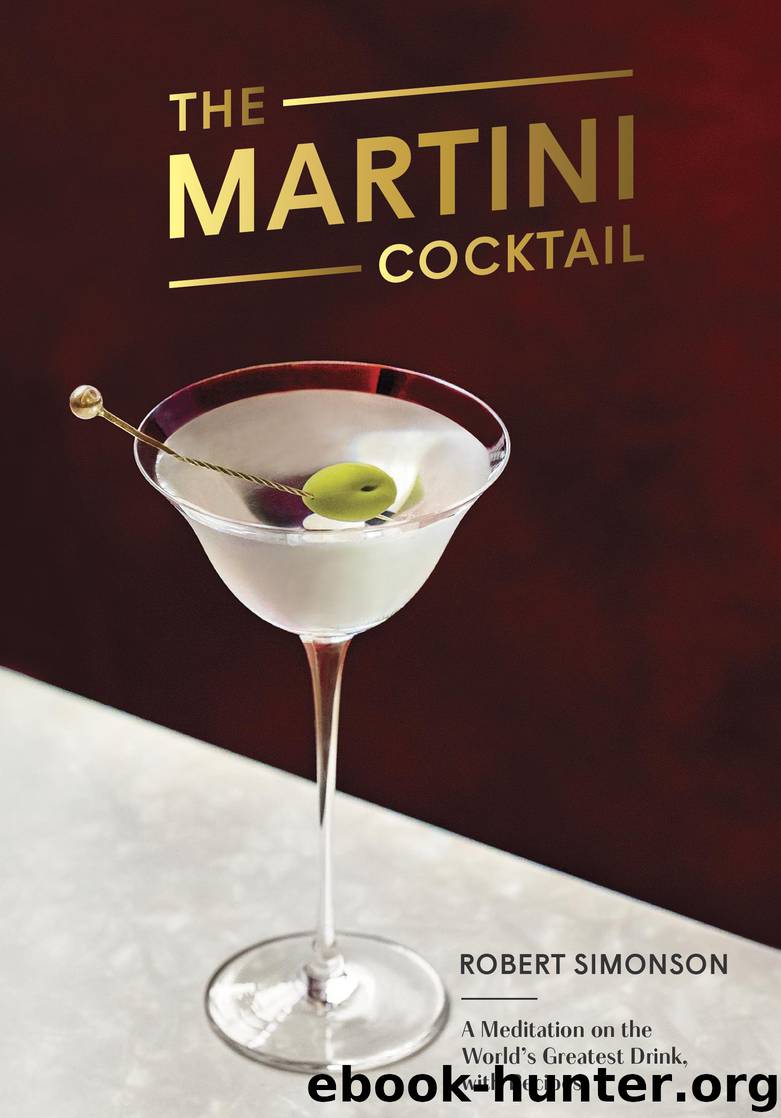The Martini Cocktail by Robert Simonson

Author:Robert Simonson
Language: eng
Format: epub
Publisher: Potter/Ten Speed/Harmony/Rodale
Published: 2019-09-16T16:00:00+00:00
“Clean” was the watchword for the Martini for most of the twentieth century. It was a sleek, see-through, unsullied thing. But as the new millennium approached, a cloud cast a shadow upon that silvery sea.
The dirt in a dirty Martini is brine, usually olive brine, but sometimes cocktail-onion brine. Bartenders started slipping a little of the salty stuff into the usual mix of gin or vodka and vermouth in the early ’90s, when the “tini” craze was just beginning and an Anything Goes sign had been hung on the lip of the Martini glass. At first, journalists put the “dirty” in quotes to denote its oddness. By 1996, they dropped the punctuation; everyone knew what a dirty Martini was, because everyone was drinking them. By 1999, Tanqueray gin saw which way the wind was blowing; the brand’s fictional mascot, Mr. Jenkins, sailed the seas in a yacht called the Dirty Martini. (He also died in that yacht when Tanqueray decided to end the ad campaign. Jenkins’ craft was reported to have capsized in the English Channel.)
Dirty Martinis weren’t entirely a new idea. Brine made cameo appearances in Martinis throughout the twentieth century. A recipe for an Onion Cocktail in Beverages de Luxe (1914), by George R. Washburne and Stanley Bronner, called for three to four dashes of onion brine, along with orange bitters, dry vermouth, and gin, and a cocktail onion garnish. G. F. Steele, in his 1934 volume My New Cocktail Book, prescribed a drink made of equal parts gin and French vermouth; dashes of Angostura, orange, and Peychaud’s bitters; and a teaspoon of olive brine. Franklin Delano Roosevelt, an enthusiastic Martini advocate who would shake up a drink at the drop of a hat, and whose product was said to be of highly variable quality, was reported to have splashed a bit of brine in his drinks at the White House. Because of this, many have called FDR the author of the dirty Martini.
If so, it took the public until the Clinton administration to catch on. But when people did, boy did they. Soon enough there were “very dirty martinis” and “filthy martinis.” Brine had never had it so good since the day some publican decided to put a jar of pickled eggs on the bar top. But who were the people who drank dirty Martinis? Perhaps they were the same sorry souls writer Bernard DeVoto described back in 1951, who “in some desolate childhood hour someone refused…a dill pickle and so they go through life lusting for the taste of brine.”
The protests of the Martini purist did little to discourage orders for the drink. Eventually, some bartenders tried an if-you-can’t-beat-’em-join-’em approach, electing to improve the unavoidable cocktail rather than banish it. Australian barman Naren Young perhaps went the furthest with his Olives 7 Ways, created while he was beverage director of Saxon & Parole, in Manhattan. The drink had as many working parts as a Swiss watch, including an olive distillate, made by sending chopped Cerignola olives
Download
This site does not store any files on its server. We only index and link to content provided by other sites. Please contact the content providers to delete copyright contents if any and email us, we'll remove relevant links or contents immediately.
| Beer | Cocktails & Mixed Drinks |
| Coffee & Tea | Homebrewing, Distilling & Wine Making |
| Juices & Smoothies | Wine & Spirits |
101 Whiskies to Try Before You Die by Ian Buxton(44794)
World's Best Whiskies by Dominic Roskrow(44734)
Whiskies Galore by Ian Buxton(41877)
Craft Beer for the Homebrewer by Michael Agnew(18140)
Right Here, Right Now by Georgia Beers(4124)
Not a Diet Book by James Smith(3335)
Water by Ian Miller(3126)
The Coffee Dictionary by Maxwell Colonna-Dashwood(3062)
Kitchen confidential by Anthony Bourdain(3007)
Coffee for One by KJ Fallon(2565)
Smuggler's Cove: Exotic Cocktails, Rum, and the Cult of Tiki by Martin Cate & Rebecca Cate(2469)
Superfood Smoothie Bowls: Delicious, Satisfying, Protein-Packed Blends that Boost Energy and Burn Fat by Chace Daniella(2387)
Talking as Fast as I Can by Lauren Graham(2380)
Beer is proof God loves us by Charles W. Bamforth(2370)
Bourbon: A Savor the South Cookbook by Kathleen Purvis(2244)
A Short History of Drunkenness by Forsyth Mark(2233)
Eat With Intention by Cassandra Bodzak(2154)
Cocktails for the Holidays by Editors of Imbibe magazine(2081)
Colombia Travel Guide by Lonely Planet(2062)
